#multi-functional centralized island
Explore tagged Tumblr posts
Photo

Craftsman Home Bar in Cleveland Inspiration for a mid-sized craftsman l-shaped light wood floor wet bar remodel with an undermount sink, flat-panel cabinets, light wood cabinets, granite countertops, beige backsplash and glass tile backsplash
0 notes
Text
The Talon Roost
Nestled along the rugged shoreline of Puget Sound, just outside the bustling heart of Unity City, Terra, Melissa Hazen and Theodora Marten-Steiner’s home exudes a warmth and intimacy that starkly contrasts with their imposing public personas. Known as “The Talon Roost,” this sprawling lodge combines the rustic charm of traditional log cabin architecture with the subtle integration of cutting-edge technology from Terra’s civilian sector.
The Talon Roost sits perched on a rocky bluff overlooking the Sound, its timbered exterior blending with the surrounding forest. Massive, hand-hewn logs form the structure’s frame, their natural grain and texture preserved to honor the timeless beauty of the Pacific Northwest. The lodge’s roof is made up of a mix of eco-friendly solar tiles and living greenery. Wide wraparound decks extend from the main structure, offering panoramic views of the water and mountains beyond. A series of cascading stairs, lined with ambient lighting, leads down to a private dock where a sleek, automated watercraft rests, flanked by kayaks and a small security boat. At night, the lodge glows warmly, its large windows offering glimpses of life inside—a sharp yet inviting contrast to the quiet wilderness outside.
Entering the Talon Roost feels like stepping into a sanctuary. High vaulted ceilings, supported by massive wooden beams, create a sense of openness, while large floor-to-ceiling windows flood the space with natural light during the day. The interior décor balances modern minimalist design with the cozy aesthetics of a mountain lodge. Neutral tones dominate, accented by vibrant greens and golds—an homage to Melissa’s Jade Falcon heritage. The heart of the lodge, the living room, is anchored by a double-sided fireplace made of locally quarried stone. The hearth radiates warmth, surrounded by plush sofas and armchairs adorned with patterned blankets and throw pillows. Above the fireplace, a holographic display can project serene landscapes or serve as an entertainment hub, though it’s often turned off, leaving the room in serene simplicity. The kitchen combines the rustic appeal of handcrafted cabinetry with state-of-the-art appliances. A long central island, topped with polished stone, doubles as a communal dining space. The open floor plan flows into the dining area, where a custom-built table—crafted from salvaged driftwood—sits beneath an impressive chandelier of crystal and wrought iron. A cozy library, lined with shelves of books and historical texts, offers a quiet retreat for both Melissa and Theodora. A vintage mahogany desk sits at the far end, equipped with a concealed holo-terminal for secure communication and work. Nearby, a comfortable reading nook overlooks the Sound, with a soft chair and a small table perpetually holding a steaming pot of tea. The large, lavish, and highly advanced home theater was Theodora's pet project - it is outfitted with the absolute latest in cutting-edge holographic, trideo, and flat screen projection technology as well as a sound system that cost nearly as much as a light BattleMech.
While The Talon Roost appears traditional, its technology is anything but. Discrete panels throughout the home provide instant access to climate control, security systems, and personal AI assistants. The lodge’s power is supplied by a combination of renewable sources, ensuring self-sufficiency even during extended outages. A secure Star League-era communication hub is integrated into the study, allowing Melissa and Theodora to stay connected with SLDF operations. Beneath the lodge, hidden from view, lies a private hangar with bays large enough for both Melissa’s Highlander and Theodora’s Atlas, as well as the company of security 'Mechs on-site. Advanced automated repair systems and diagnostic tools ensure the 'Mechs are always ready for action. Also included is a multi-functional room utilizing advanced Holotank technology capable of projecting tactical simulations, training environments, or serene natural landscapes for relaxation.
The grounds around the lodge are meticulously curated. A path winds through a grove of ancient cedar trees to a private firepit surrounded by log benches. Nearby, a greenhouse houses a mix of local flora and medicinal plants, along with herbs for Theodora’s favorite recipes. A falconry mew, discreetly tucked into the edge of the property, is home to a small cast of Jade Falcons whom Melissa tends to personally—a connection to her heritage and a calming pastime away from the demands of leadership. The Talon Roost’s atmosphere is one of quiet strength and serenity. For two figures as legendary as Melissa Hazen and Theodora Marten-Steiner, the lodge represents a refuge from the chaos of the Inner Sphere—a place to reconnect with nature, their shared history, and each other. The cozy interiors, paired with the breathtaking natural surroundings, create a space where visitors are immediately put at ease, despite the immense power and influence of its owners. This dichotomy—between public and private life, between war and peace—is what makes The Talon Roost not just a home, but a reflection of the lives Melissa and Theodora have built together.
While The Talon Roost exudes an aura of peace and natural harmony, its security infrastructure rivals that of any high-level military installation. As the personal residence of two high-ranking SLDF officers, it incorporates layers of cutting-edge technology, physical deterrents, and personnel to ensure the safety of its occupants and maintain its strategic utility. The property is surrounded by an invisible perimeter system that utilizes advanced motion detection, thermal imaging, and seismic sensors. Any unauthorized entry triggers both silent and audible alarms, alerting the SLDF garrison stationed nearby. Discrete but highly effective automated turrets, hidden in the rocky outcroppings and among the trees, are equipped with non-lethal crowd control measures and high-powered laser weaponry for more extreme threats. Signature reduction technology derived from Null Signature System technology shields The Talon Roost from all but visual aerial and orbital scans, while a squadron of SLDF-designed surveillance drones patrols the airspace and property boundary. These drones are equipped with stealth tech, high-resolution cameras, and lethal weaponry. Meanwhile, the picturesque firepit near the cedar grove doubles as an emergency bunker entrance, reinforced to withstand even orbital bombardment. Decorative stone statues around the property conceal sensors and emitters capable of deploying small scale energy weapons in emergencies.
The Talon Roost is protected by a small, elite detachment of SLDF Royal Black Watch troops. While their presence is unobtrusive, they are always ready to respond to any threat. The guard detachment includes three Stars of MechWarriors, with their BattleMechs stationed in the Roost's subterranean hangar. A company of infantry, drawn from the Royal Black Watch's commando-trained operatives, patrols the property and acts as a rapid reaction force. All on-site security personnel reside in a concealed bunker built into the cliffside upon which the Roost perches. Security details rotate regularly to maintain optimal readiness and avoid becoming predictable. A concealed, automated command center under the lodge handles all security and monitoring tasks. Operatives stationed here can communicate directly with SLDF High Command and deploy additional resources as needed.
Beneath The Talon Roost lies a complex network of subterranean tunnels, elevators, and passageways that connect the property to critical SLDF and Star League installations in the region. This link allows both Melissa and Theodora to access secure meeting rooms or emergency operations centers without requiring surface travel. A direct maglev transit tunnel leads to both the nearby Tacoma Castle Brian, as well as the SLDF's Citadel inside Unity City itself - rebuilt by the SLDF to once again serve as their High Command complex. The headquarters of the Royal Black Watch, Fort Cameron, is linked to the lodge by another high-speed maglev route. The connection allows Theodora to oversee her regiment's activities or deploy her Atlas in minutes. The lodge is also connected via the maglev-tunnel system directly to the Court of the Star League.
In the event of an overwhelming threat, the lodge’s subterranean systems include a concealed evacuation pod capable of transporting occupants to either the Citadel or Fort Cameron in under five minutes. The lodge also features a last-resort self-destruct mechanism. Activated only by voice authorization from Melissa or Theodora, this system ensures no critical technology or data can fall into enemy hands. In case of a siege, the lodge can deploy automated counter-battery defenses, jamming fields, and active missile interceptors hidden within the terrain.
While The Talon Roost offers warmth, serenity, and a welcoming atmosphere, its hidden security and strategic capabilities reflect the immense responsibilities carried by its owners. This stark juxtaposition mirrors the lives of Melissa Hazen and Theodora Marten-Steiner, who must balance their personal sanctuary with their duties as protectors of humanity’s future. It is a place of respite, but one always ready for the call to action.
7 notes
·
View notes
Text
Book Review: Tress of the Emerald Sea
Tress of the Emerald Sea is a wonderful, layered adventure that evolves as the priorities of Tress, our main character, ebb and shift. Tress is a young girl from a barely habitable rock, surrounded by a sea of spores that turn into vines when they touch water. Her friend and love interest, Charlie, the son of the island’s Duke, is sent to the island of the King to be married. When he makes himself completely undesirable, the King sends him to the Midnight Sea (another of several spore seas, each with their own distinct properties) where he is captured by the fearsome Sorceress.
Tress, when she finds out, sets off on a grand adventure to save him. On the way, she becomes part of a pirate crew, driven by the fearsome Captain Crow, and meets Fort, Ann, and Salay, as well as Hoid, a world-hopping character of the wider Cosmere who is cursed by the Sorceress. As Tress seeks Charlie, she becomes embroiled in a conflict between the crew and their captain. This multi-tiered adventure keeps the story fresh and engaging. Of the people Tress meets, Ulaam in particular stands out as a delightful character whose presence brings fun and unpredictability to his scenes. An ear on your arm, anyone?
One of the key strengths of the novel is how its conflicts are solved through different means. Some through combat, sure, but also through wit and quick-thinking. These keep the tension high in the right places, and show Sanderson’s skill in crafting a variety of situations and solutions for his characters. I am a massive fan of different ways of solving problems beyond force—the scene with Xixis the dragon was my favourite—so this scratched a real itch for me.
The world building, as one would expect of Sanderson, is top-tier. The spores and how they function are cool and varied, and the way they are built into the story is very satisfying. Likewise, the narrative voice, provided by the cursed Hoid (who is rendered to something of a ‘village idiot’ with no fashion sense), connects the novel to the broader Cosmere. Hoid is witty and fun, and this keeps the narrative light. It is also refreshing to have the story told by a third party who is able to comment personally on what is happening without being the centre of the story. I did find some of Hoid’s observations to disrupt the immersion in places—e.g., the reference to ‘laptops’ being a key one. I get that this is supposed to broaden out the links to the world beyond, but, as someone unfamiliar with the rest of the universe, I found it a little jarring.
Also, Tress’s character development, while clearly central to the story, does sometimes suffer from exposition that I found a little heavy-handed. There are moments when the narrative explicitly states that Tress is changing or growing, even when I think readers can see these changes organically. It’s a little unnecessary and on-the-nose. And, lastly—SPOILERS—certain plot elements create minor inconsistencies that detract from the otherwise cohesive world. For example, the Sorceress has inhabited the planet for years and possesses advanced knowledge of technology that Tress is only beginning to develop. When Tress offers to trade this technology, the Sorceress dismisses it—yet later, her guards are defeated by this very same technology. This inconsistency feels like an oversight that somewhat weakens the internal logic of the story.
Regardless of some minor flaws, Tress of the Emerald Sea is an easygoing, refreshing sci-fi/fantasy adventure with a cast of loveable characters. The story is accessible and easy to follow, is told with humour, and sits against a well-fleshed-out and intriguing world. It gets a big ‘recommend’ from me!
#brandon sanderson#tress of the emerald sea#book review#fantasy books#cosmere#hoid#adventure novel#pirates#magic system#character development#fantasy recommendations#spore magic#bookish#cosmere novel#good reads#books#reading#booklover#booklr#book recommendations#fantasy#science fiction
4 notes
·
View notes
Text
Countries - North America
I currently working on denominations in Califinity, mainly the two biggest ones. However, I hit a snail due to just trying to think up names for it. Like, GRR Martin said he doesn't bother with it for Westeros' names like The North and King Landing, but I am obsessed with namings. If the name doesn't have meaning, or doesn't looks right, I gonna fucking throw myself off a bridge.
Anyways, right now I focusing on North America states because there are a lot more countries than ours today. And I including Central America and the Caribbeans, because it's still part of North America. I will also talk about UNAC, which is a supernational union similar to today EU (EU was already federalized in bhna contemporary) and superseded NAFTA.
United States of Fredoia
I already talked about Fredoia briefly on my last post, only that it superseded the USA. Fredoia inherited the majority of USA lands (there were time they didn't, thanks to Neo-Confedercy). They did lose many lands due to many Native tribes declaring independence (I will elaborate that later).
Like USA before, Fredoia kept it capital city where Washington, DC was, and like Washington state, its name is change (maybe Unionpolis, very original lol). It incorporated Arlington Country and Alexandra City, giving DC a total land area of 270 km². It population should be around 3 million. It administration level will be called a metropolis-state level: it status is equal along with other states (they are represented at congress), but it functions more as a city.
New York City is also a metropolis-state, incorporating counties and cities in its surroundings, including Hudson Country, NJ(yep, Jersey City included). However, it lost being the biggest in the US (being now 18 mil), Metropolis of Los Angeles is bigger, far bigger (24 mil). Also, they rebuilt Penn Station, now called Empire State Central Station.

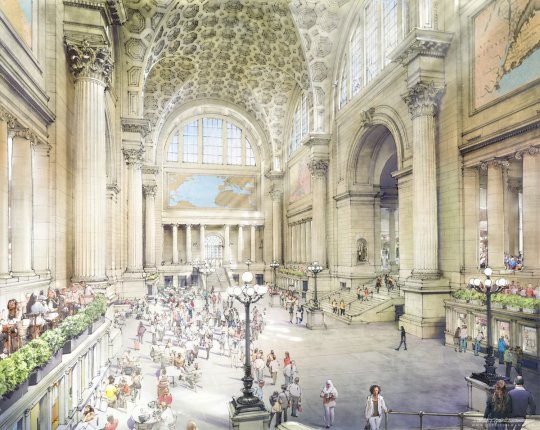
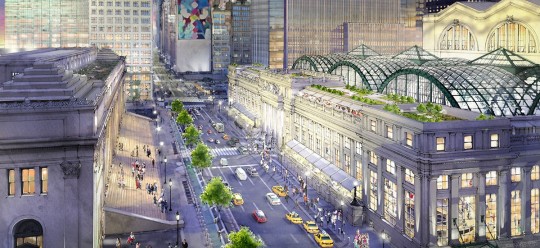
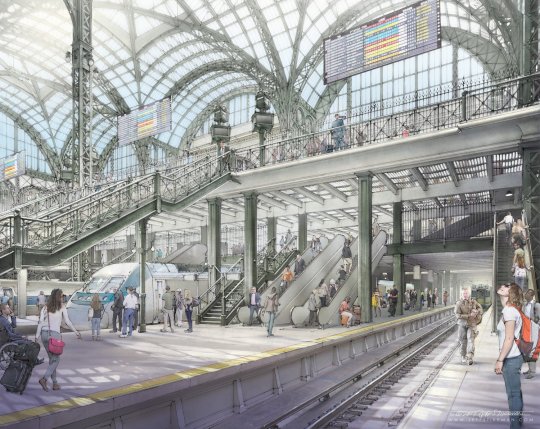
Also, voting systems and constituents' representation are different. It is a proportional representation by parties, meaning Fredoia has a multi-party system. The head of state and head of government is separated, and its government structure is a parliamentary republic like Germany.
Thanks due to quirks, immigration, civil wars, geographical barriers, and the fact that this takes place hundreds of years later, Western and Eastern Fredoia have very different cultures compared to today. How people differentiate West and East is by geographic barriers like how we do so with Mississippi River. The Rocky Mountains Range helped differentiate the two regions.
For one, Latines are now the majority in California, Arizona, New Mexico, Nevada, and other Western states (maybe not Oregon nor Washington). There are already articles that projected this will happen. What is unique due to the mixture of Latine and Anglo culture, especially the language, created a new ethnicity called Californians (Kalifornán written as gender neutral). They even developed a unique language called Kalifornán in its native language (Kalidán if you read my other post for Dune). It's a mixture of Spanish and English, mainly that Spanish superceded English phonetics and any words that were originally French. However, many English words still remain, words like ín (and), islán (island), lán (land), ríf (river), and such. Also, some letters change due to pronunciations, like Spanish J is now Hr (Juan will spell Hruan), Spanish and English Ch, along with English J is now Ç. The C that pronunced similar to the word city is now S (reason why Frinsica has an S now). I gonna write a post for this.
One key factor for Californians' ethnicity is that the majority are Califinitans. The majority of Fredoia Califinitans are located beyond the Rocky Mountains, with exceptional of Upland South-

-due to The Great Blooming and the Neo War. Almost all of those in Upland are what I called Deitist: believing that Califia is someway a deity.
There is also a new ethnicity/race called Biras (Birace?Biase?). They are the English version of Mestizos. I was thinking that since interracial is more acceptable, and therefore more biracial children, that will be far more biracial in the future. I will think they will be the majority (maybe 1/3?), though they will likely have different groups depending on their background. Sasha Waybright is likely a Biras, however, this will depend on if her one or both her parents are from the Eastern. She probably will view herself as a Mestiza since she will be a Kalifornana.
I also want to create a different post that focuses only on the State of California.
Native American States
After the Second Civil War, many Native American tribes declared independence. How many, I don't know, and to be honest, I don't think it is more than 10. Right now, I gonna create ones from the US since I more familiar with it. There likely are independent First Nation states in Canada, and there definitely is a Mayan state in the Yucatán Peninsula (and maybe whatever the Zapatistas are controlling now).
Kingdom of Hawaii
This was already a no-brainer as there is already a sovereign movement by Native Hawaiians. Honestly, it is rather they would have a monarchy or republic is the question.
This part is going a bit controversial, but once the USA government kinda just collapsed, there was a lot of chaos in the islands. There was a massive exodus, many who were non-native, who went back to the states. However, there was also an expulsion of other non-native, even those were not white, by Native Hawaiians; there were conflicts between two groups who wanted to either remain in the union or become independent, which led into this. Hawaiia also has a right of return for diaspora Hawaiian like many other countries do.
The capital is still Honolulu. They are a member of UNAC. When Amphibia was transported at the Pacific, Hawaii claimed some islands in its southern water that were uninhibited. There are political tension between the and the Kingdom of Newtopia due to this, and also the fucking megafaunas they traveled to the islands.
Navajo-Hopi Nation
Again, a no-brainer, however, the thing that was a bit shockingto me was that there is another tribe reservation inside Navajo. I was wondering why there was a hole in Navajo until I look at a proper map and saw Hopi in it lol
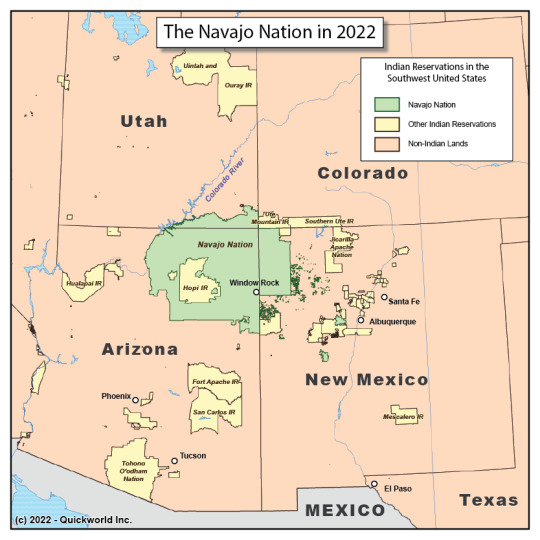
(Other reservations in the East likely will be incorporated simply because Navajo-Hopi ask them "hey you wanna join us?")
Honestly, it likely they had the most peaceful transition: it isolated thanks to being in a desert (and behind the Rocky Mountains), there is not that many non-native in it to begin with, there are other issue happening for the USA government to worry about, and the most hilarious reason, is that they never publicly declared independence. They decided to ignore DC and acted like an independent country for either half to nearly a century.
I don't know if Navajo-Hopi should be a binational state or not. Binations don't usually last that long, and there are other non Navajo-Hopis that live in the nation. The capital city is Jeddito, an actual place in Navajo that is inside Hopi. Population in the nation should be around 10-15 mil. NH is part of UNEC.
Republic of Lakotah
Likely the biggest Native country if Alaska isn't independent. It is actually based on a proposal state for Lakota.

It capital and largest city is Omaha (will go by a different name). The city is right on the tip, and it is the most important city as it is connected with the Mississippi River.
Even though Lakotah is meant for Lakota, there are other Native tribes who emigrated to it. There is likely ethnic tension between Lakota and the other non-Lakotas, but I don't think it won't be as awful as other places.
Of all the native states, Lakotah was the most violent; the country situated in five Republican states. The likely reason how they managed to gain independence is due other tribes from the surrounding coming over to help (similar to Bleeding Kansas). And anti-quirks were not as pivotal or heated compared to Whites (especially Republicans), so while Whites were fighting among themselves about quirks, quirks and non-quirks Native were teaming up.
There is a unique architecture in Lakotah, buildings which are called Tipi. Tipi are small, arcological buildings that are meant to house either 2,000 to 10,000 people. They primarily house people without hurting the environment. They are small, 1/4 to the size of a square kilometer. What is unique is that it is a commune, allowing people to share and control resources via democratically. It's the only place on Earth where they have true communism. How Tipi interspersed the lands is unique because I got the idea from Not Just Bike on his video of Switzerland. Lakotah is a sprawling country, where half the population lived in 5 major cities, and the other half lived in Tipi in said city's region or somewhere else. Instead of having sprawling suburban like the USA and Canada, Lakotah is sprawled by Tipi.
Lakotah land area is 200,00 km², with a population of 55 mil., and Omaha population is 10 mil.
It is also a member of UNAC
Country around Oklahoma
I know for a fact that tribes in Oklahoma declared independence too, the only issue is I don't know a name for it. There are multiple ethnicities in Oklahoma, and there likely need to have a lingua franca.

I still gonna call it Oklahoma. Oklahoma City is the capital, with a population of around 1-2 mil. The country itself is 15-20 mil. Oklahoma is a member in UNAC.
Maya Republic
Mayas initiated their country during the Dark Age/Vigilant Era, like the four other countries I mentioned. And when i said Maya, I mean Indigenous Mayas , not Mestizos who don't identify as such. The Maya Republic controls Chiapas, Yucatán Peninsula, Belize, and Northern Guatemala.

I don't know where the capital city will be. Either Mérida in Yucantán, Jovel, or Tuxtla Gutiérrez. Population is likely at 30 million. Maya is a member in UNAC.
The majority of Mayas are likely Califinitans, though I don't know if they will be deitists or nondeitists.
UNAC
UNAC, or United North America Confederacy, is what I said before: a supernational union similar to EU. And I mean similar in many ways.
Border between UNAC members are open, there is a singular currency (called Uneso), no visa required for nationals when working in different countries, UNAC Nationals allowed to vote and stand in office in local government, no restrictions in trading, etc. There is not much standard when it comes to infrastructure. However, they do have major projects for UNAC to feel more connected. Almost all railways in mainland North America are electrified (25kv/50hz), all have standard gauge, have uniformed signals, and are connected. It's theoretically possible to take an hsr (450 kph) line or two from New York City to Panama City. But a more preferrable opition is a Maglev (750 kph) line, which goes directly to either city.
The capital city is at Rio Grande mouth, called Rio Grande City. It picked for a symbolic reason: Rio Grande separated Latin and Anglo culture, the treatment of Mexican, and proxy Latines, by the former USA, and picking the capital on the mouth bonds the two cultures together.
The city population is around 20-25 million. Some interesting things i think up is that there is a lot of bodies of water in Rio Grande City, like what it is today-

-so the city kinda looks like Venice. There are artificial islands similar to I-Island off the coast, though they are much smaller, likely at average of 10-50 km². There is a pro-hero academy meant for UNAC national students. There is also a Triwizard-like tournament for Pro-heros academies, and it is always hailed in the city.
I think the UNAC government is similar to the EU along with Switzerland. It has two legislative, one voted by population, another by it state government. There is also a commission committee that handed making laws, but I too lazy to look it up. UNAC Senate, the one elected by population, has a degressive proportionality when giving each state senator. Let's be honest, Fredoia will fucking out vote every countries due to having the highest population. Mexico comes in second by population, with maybe a population of either 250-300 mil, but even then, adding all the other countries, they still won't outnumbered Fredoia, even if Fredoia did lost many states before. So, small countries (maybe less of 10 mil?) automatically have 5 senators, and the Senate will apportioned senators accordingly. Likely Fredoia only filled 1/3 of the Senate. The executive branch is a council of each countries head of state and government, like the EU.
Amphibia and the Boiling Isles
Amphibia can't be a member due to it government and representation. Even though Amphibians could elect local leaders, non-Newts can't vote for the supreme legislative body, and the kingdom is a semi-constitution monarchy. Like, UNAC is okay with Hawaii being a monarchy (if Hawaiians choose it) as it government is very much a constitution monarchy. The monarch has restricted power, similar to the British monarch. Andrias has far more privileges that will make UNAC very uncomfortable. There is some trade right between the two, and the Amphibians do have an easier time getting a visa (this I imagine how Hop Pop and two kids manage to enter California).
For BI, it is complicated. BI is situated in the middle of the Atlantic, and therefore does not feel connected to North America. Actually, there's likely tension between UNAC and BI (and likely other countries, especially EU and West Africa countries). Many of the islands block shipping lanes, so conflicts between BI and other countries are likely to happen. Doesn't help they are also do magic and far more non-humanoid like.
Not only that, but BIS are very isolationist. Rarely do they connect with the outside world. Even when Belos becomes emperor, it didn't really change its isolational policy other than scaring other countries because now they are united and far more powerful.
There's nothing else much to talk about. In the EU, they have a similar international pro-hero academy for EU national students to learn together -this is the premise for snk/bnha fic, where 104th class are a pro-hero class (Eren was a non-quirk until his father gifted him one, and not only Ymir (freckles) is from a famous and loving pro-hero parents, but she also in an arranged marriage with Historia, her childhood best friend).
Anyways, that's it.
#bnha#mha#boku no hero academia#my hero academia#bnha fanfic#mha fanfic#bnha fanfiction#mha fanfiction#fanon#bnha fanon#the owl house#amphibia#dune#dune part two#sasha waybright#ymir#ymir freckles#historia reiss#yumihisu#eren yeager#aot#attack on titan#bnha au#native american#maya#Hawaii#worldbuilding
6 notes
·
View notes
Text
What Is the Kitchen Triangle Rule?
Ever feel like you’re running a marathon in your kitchen? If your cooking space is chaotic, you may be dodging cabinets, bumping into countertops, or taking extra steps to grab a spatula so you might have a layout problem. That’s where the kitchen triangle rule comes in.
It’s not just some fancy design theory; it’s been shaping kitchens for decades to maximize efficiency and functionality. If you’re planning a kitchen remodel in Lake County, IL, or working with kitchen and bath remodelers, this simple concept could save you time, energy, and frustration.
The Kitchen Triangle Rule: A Recipe for Efficiency
The kitchen triangle (also called the "work triangle") is all about strategic spacing between the three most-used areas in your kitchen:
The stove (where you cook)
The sink (where you prep and clean)
The refrigerator (where you store ingredients)
The idea? These three points should form a triangle, making it easy to move between them without unnecessary steps.
Here’s the general rule:
The total perimeter of the triangle should be 13 to 26 feet
No side of the triangle should be shorter than 4 feet or longer than 9 feet
Nothing (like islands, cabinets, or trash bins) should block the triangle
Think of it as designing your kitchen like a well-organized dance floor—you want smooth, uninterrupted movement between each step.
Why Does the Kitchen Triangle Matter?
Ever cooked in a kitchen where the fridge is miles away from the stove or the sink is crammed into a weird corner? Annoying, right? The kitchen triangle rule prevents inefficiencies that lead to wasted time, extra effort, and even potential safety hazards.
Here’s why it’s still a go-to concept for kitchen designers and home builders:
Saves time – No more crisscrossing the kitchen 20 times while making dinner.
Boosts safety – Keeps the cook from navigating through a maze with hot pots or sharp knives.
Maximizes workflow – Whether you’re a solo chef or cooking with family, everything’s within reach.
But let’s be real—kitchens today aren’t all cookie-cutter. Open-concept layouts, kitchen islands, and multi-cook households have stretched the limits of the traditional triangle. So, how does this rule apply today?
Modern Kitchens: Does the Triangle Still Work?
Short answer: Yes, but with some flexibility. The kitchen triangle was originally designed in the 1940s, when homes had smaller, more enclosed kitchens. Today, layouts are more open, and kitchens often serve as entertainment hubs, not just places to cook.
So, while the kitchen triangle is still useful, modern kitchens sometimes shift towards work zones instead.
Work Zones: The Triangle’s Evolved Cousin
Instead of a strict triangle, many modern kitchen designs focus on zones tailored to different tasks:
Prep Zone – Cutting boards, knives, and trash are nearby near the sink.
Cooking Zone – Around the stove, with easy access to pots, pans, and spices.
Storage Zone – Fridge, pantry, and dry goods are all within reach.
This is especially useful for:
Larger kitchens that need multiple prep areas.
Kitchens with islands where the sink or stove is centrally placed.
Households with multiple cooks, so no one gets in the way.
So, if your kitchen doesn’t fit the classic triangle, don’t stress—a well-planned layout that prioritizes efficiency is what matters.
How to Apply the Kitchen Triangle to Your Remodel
If you’re planning a kitchen remodel in Lake County, IL, or working with kitchen and bath remodelers, here’s how to optimize your layout for function and flow:
1. Measure Your Triangle
Before knocking down walls or picking out cabinets, measure your space and see if your stove, sink, and fridge create an efficient triangle. If they don’t, consider shifting their placement.
2. Think About Traffic Flow
Do people cut through your kitchen while you’re cooking? If your kitchen doubles as a high-traffic area, ensure the triangle (or zones) don’t become obstacles in daily movement.
3. Consider Your Cooking Habits
Love baking? Make sure your baking station (mixer, ingredients, and oven) is conveniently placed. Into meal prepping? You’ll want extra counter space near the fridge and sink.
4. Maximize Storage Without Disrupting the Flow
Cabinetry, drawers, and pantry placement matter just as much as the triangle. Smart storage—like custom Amish cabinetry or Waldron custom closets—keeps everything within reach.
5. Keep Cleaning Easy
White shaker cabinets look sleek, but they require upkeep. Knowing how to clean shaker cabinets before choosing materials ensures you’re picking a style that fits your lifestyle.
Ready to Remodel? Let’s Build Your Dream Kitchen
Whether you’re renovating for efficiency, style, or both, a smart kitchen layout makes all the difference. The kitchen triangle rule is a great starting point, but at Waldron Construction, we tailor designs to fit your needs—whether that’s a traditional triangle, modern work zones, or something in between.
If you’re looking for kitchen remodeling, new home construction, or basement finishing services in Lake County, IL, we’re here to help.
1 note
·
View note
Text
Outdated Kitchen? Here’s Why Arvada Homeowners Are Investing in Luxury Kitchen Remodeling Services!

Is your kitchen feeling more like a relic than a retreat? If you’re in Arvada, Colorado, and find yourself typing “kitchen remodeling services near me” into your search bar, you’re not alone.
Many homeowners are recognizing the value of transforming their outdated kitchens into luxurious, functional spaces that not only enhance daily living but also boost property value.
The Heartbeat of the Home
The kitchen has evolved beyond a mere cooking space; it’s now the epicenter of family gatherings, entertaining guests, and even remote work.
A well-designed kitchen can significantly improve your home’s functionality and aesthetic appeal. In fact, a minor kitchen remodel can recoup up to 96.1% of its cost upon resale, making it one of the smartest investments for homeowners (source).
Trending Now: What’s Hot in Kitchen Design
Staying abreast of current trends ensures your kitchen remains both stylish and functional.
Here are some of the top kitchen remodeling trends for 2025:
Natural Materials
Incorporating elements like wood, stone, and metal adds warmth and texture. Approximately 73% of design professionals report that wood is set to be the most popular material this year (source).
2. Smart Technology
From voice-activated appliances to energy-efficient lighting, integrating smart tech enhances convenience and efficiency. Nearly 30% of homeowners now choose appliances with Wi-Fi connectivity (source).
3. Open Shelving
This minimalist approach not only creates an airy feel but also encourages organization and display of cherished items.
4. Bold Colors
Moving away from all-white kitchens, homeowners are embracing deep hues like navy blue and forest green for cabinetry and accents.
Budgeting for Your Dream Kitchen
Understanding the costs involved helps in planning effectively.
Cabinetry: Often the most significant expense, new cabinets can account for nearly 40% of the overall budget, averaging around $8,400 (source).
Appliances: Upgrading to energy-efficient models not only modernizes your kitchen but also offers long-term savings.
Countertops and Flooring: Materials like quartz and marble are popular choices for their durability and aesthetic appeal. Costs vary based on material and square footage.
Maximizing Return on Investment
A well-executed kitchen remodel doesn't just enhance your living experience; it also adds significant value to your home. Features like multi-functional islands, smart appliances, and quality materials are attractive to potential buyers.
Moreover, mentioning “remodeled” in your home listing can increase the sale price by nearly 4%, translating to an extra $13,194 for the average U.S. home (source).
Finding the Right Kitchen Remodeling Service in Arvada
When searching for “kitchen remodeling services near me,” consider the following:
Experience: Look for professionals with a proven track record in luxury kitchen renovations.
Portfolio: Review past projects to ensure their style aligns with your vision.
References: Seek testimonials or reviews from previous clients to gauge satisfaction levels.
Licensing and Insurance: Ensure the service provider is licensed and insured to protect your investment.
Why Arvada Homeowners Are Prioritizing Kitchen Renovations?
In recent years, homeowners in Arvada, Colorado, have been placing more focus on improving the kitchen, and for good reason. As lifestyles shift toward cooking at home, entertaining guests, and spending more time with family, the kitchen has become a central hub. It’s no longer just about function; it’s about comfort, design, and luxury.
Beyond daily satisfaction, the resale value matters too. In competitive markets like Arvada, a modern kitchen can significantly boost buyer interest and home value. Local trends show a growing preference for open layouts, statement lighting, and custom cabinetry.
Homeowners are looking for spaces that reflect their personality while offering smart storage and upgraded appliances. Whether it's a full overhaul or a partial update, investing in a high-end kitchen remodeling service has proven to be a smart, future-focused decision for many families in the area.
How to Prepare for a Kitchen Remodel Without the Stress?
Starting a kitchen remodel might feel overwhelming, but with the right steps, it can be an exciting and smooth process. Planning ahead is key. Start by setting a realistic budget not just for materials and labor but also for unexpected costs that might pop up. Experts recommend setting aside about 10-20% of your budget for surprises.
Next, gather inspiration. Use websites, magazines, or even friends’ homes to identify features you love, whether that’s quartz countertops, gold fixtures, or an oversized island. Having a clear idea of your style helps your kitchen remodeling service understand your goals.
Communication is also essential. Work with a team that listens, shares a clear timeline, and updates you regularly. Ask about materials, layout changes, and any permits needed, especially in Arvada, where local codes may apply.
Lastly, plan for life during the renovation. Setting up a temporary kitchen or arranging alternative meals can help make the process easier on your family. By preparing thoughtfully, you can stay focused on the exciting part, seeing your dream kitchen come to life without unnecessary stress.
Final Thoughts
Looking to breathe new life into your kitchen? Cooper Remodeling offers a top-tier kitchen remodeling service tailored to Arvada homeowners who want luxury, style, and functionality in one beautiful space.
Whether you’re searching for kitchen remodeling services near you or planning a full transformation, their expert team brings your vision to life with care and craftsmanship.
Don’t settle for outdated; upgrade to exceptional. From smart layouts to custom finishes, Cooper Remodeling makes it easy to love your kitchen again. Ready to get started?
Reach out today and see why so many in Arvada trust Cooper for their dream kitchen remodel.
1 note
·
View note
Text
10 Stunning Kitchen Interior Design Ideas for a Modern Home
In today’s fast-paced lifestyle, the kitchen has evolved into more than just a place for cooking — it’s a central hub for family gatherings, creative expression, and everyday comfort. Whether you live in a spacious villa or a compact apartment, transforming your culinary space into something both functional and stylish is essential. When it comes to kitchen interior design, blending aesthetics with practicality is key — and that’s where expert firms like Singh’s Interiors shine. With their tailored approach and modern design sensibilities, they turn ordinary kitchens into stunning showcases of style and efficiency.

1. Embrace Minimalist Design
Minimalism never goes out of style — especially in modern homes. Think clean lines, sleek cabinetry, handle-less doors, and neutral tones like white, grey, or beige. A clutter-free look with hidden storage and integrated appliances keeps things tidy and visually appealing. The minimalist kitchen is perfect for homeowners who appreciate calm, order, and understated elegance.
Design Tip: Opt for matte finishes for cabinets and pair them with quartz or granite countertops to maintain a contemporary feel.
2. Open Shelving for Visual Space
Open shelving is a growing trend that adds both charm and utility to kitchen interiors. It opens up the space, making the kitchen appear larger and more inviting. Display stylish dishware, cookbooks, or indoor plants to add character to your space.
Design Tip: Stick to one or two shelves per wall to avoid overwhelming the space. Choose floating wooden shelves for a modern rustic look.
3. Add a Pop of Color
While neutral kitchens are timeless, adding a pop of color can bring life and personality to your space. You can incorporate color through cabinet finishes, backsplash tiles, bar stools, or even light fixtures.
Design Tip: Deep green, navy blue, and terracotta are trending in 2025. Pair bold colors with metallic accents like brass or black matte handles for added sophistication.
4. Smart Storage Solutions
Modern kitchen interior design is incomplete without intelligent storage. Pull-out pantry shelves, corner carousel units, deep drawers for pots and pans, and under-sink organizers are excellent ways to maximize space and minimize clutter.
Design Tip: Use dividers and inserts in drawers to keep utensils and tools organized. A custom pull-out spice rack is a great functional and aesthetic addition.
5. Integrated Appliances
Seamlessly built-in appliances help maintain a cohesive, clutter-free look in modern kitchens. Integrated ovens, refrigerators, and dishwashers blend into cabinetry, enhancing the sleek appearance.
Design Tip: Choose appliances in matching colors and finishes with your cabinets to create a unified visual flow.
6. Statement Lighting Fixtures
Lighting is one of the most powerful design elements. Statement pendant lights over the island or dining area can elevate the entire kitchen design. Whether it’s industrial metal fixtures or artistic glass pendants, the right lighting sets the mood and style.
Design Tip: Install layered lighting — ambient (ceiling lights), task (under-cabinet), and accent (pendant or LED strips) — for both function and ambiance.
7. Multi-functional Kitchen Island
A kitchen island can do more than just provide extra counter space. Modern designs include storage, built-in sinks, wine racks, and even induction cooktops. For families, the island can double up as a breakfast bar or work-from-home station.
Design Tip: If space permits, opt for a waterfall-edge countertop for the island. It looks sleek and adds a luxurious touch.
8. Use of Natural Materials
Natural elements like wood, stone, and bamboo bring warmth and texture to modern kitchen spaces. Wooden cabinets, marble countertops, or natural stone backsplashes can soften a modern design, making it more inviting.
Design Tip: Mix natural textures with modern finishes — like a reclaimed wood countertop paired with high-gloss white cabinets — for a balanced look.
9. High-Gloss or Matte Finishes?
Choosing the right finish can dramatically impact your kitchen’s vibe. High-gloss surfaces reflect light and are ideal for smaller kitchens, making them appear larger. Matte finishes, on the other hand, offer a softer, more refined look and are gaining popularity in contemporary homes.
Design Tip: Go for a two-tone look — matte finish base cabinets and high-gloss upper cabinets — to create visual interest without overwhelming the space.
10. Eco-Friendly and Sustainable Design
Sustainable design is not just a trend — it's a necessity. Incorporating eco-friendly materials and energy-efficient appliances is a great way to modernize your kitchen while being kind to the planet.
Design Tip: Opt for bamboo cabinetry, recycled glass countertops, or VOC-free paints. Consider LED lighting and water-saving fixtures to make your kitchen greener.
Final Thoughts
Creating a modern kitchen is all about blending beauty, functionality, and innovation. Whether you're drawn to clean minimalism or bold contemporary styles, these 10 stunning ideas can help you design a kitchen that meets your needs and elevates your home's overall aesthetic.
A well-designed kitchen doesn’t just look good — it enhances your lifestyle. It’s where family memories are made, recipes are tried, and laughter is shared. When you’re ready to begin your kitchen transformation, don’t hesitate to consult professionals like Singh’s Interiors, who specialize in customized kitchen interior design solutions. Their expert team can turn your vision into a stylish and practical reality tailored perfectly to your home and lifestyle.
0 notes
Text
The Role of Irrigation Systems in Commercial Landscape Maintenance
Effective landscape maintenance on commercial properties requires more than just regular mowing or trimming. One of the most critical components of successful commercial landscape maintenance is an efficient and well-managed irrigation system. Whether for office parks, retail centers, industrial campuses, or municipal grounds, proper irrigation plays a key role in keeping landscapes healthy, green, and attractive throughout the year.
Why Irrigation Systems Are Essential in Commercial Landscape Maintenance
Consistent Water Distribution
Commercial landscapes often cover large areas with varying plant types, soil conditions, and exposure to sunlight. Manual watering or inconsistent water application can lead to patchy lawns, plant stress, or even overwatering. A professionally designed irrigation system ensures that every part of the landscape receives the right amount of water, promoting uniform growth and preventing waste.
Water Conservation and Efficiency
Water usage is a major concern for commercial properties, especially in regions with drought restrictions or high utility costs. Modern irrigation systems use smart technology—such as weather sensors, moisture meters, and programmable controllers—to optimize watering schedules. These systems automatically adjust based on weather conditions, ensuring efficient water use and compliance with local water regulations.
Healthier Plants and Turf
Irrigation systems contribute directly to the health and longevity of commercial landscapes. Well-regulated watering supports strong root development, reduces the risk of disease, and enhances plant resilience to seasonal changes. Proper hydration also prevents soil compaction and erosion, which are common issues in high-traffic commercial areas.
Types of Irrigation Systems Used in Commercial Properties
Sprinkler Irrigation Systems
Sprinklers are a popular choice for lawns and open green spaces in commercial settings. They provide wide coverage and can be customized to fit various zones within a property. With automatic timers and adjustable spray heads, sprinkler systems offer both convenience and control.
Drip Irrigation Systems
Drip irrigation delivers water directly to the root zones of plants through a network of tubing and emitters. It’s highly efficient and ideal for flower beds, hedges, and landscaped islands in parking lots. Drip systems reduce evaporation and runoff, making them perfect for properties looking to conserve water while maintaining vibrant plant life.
Smart Irrigation Systems
Smart irrigation incorporates advanced technology like weather forecasting, real-time sensors, and remote access. These systems allow property managers to monitor and adjust irrigation schedules from a mobile device or central hub. This level of control is especially useful for multi-site commercial properties or large campuses.
Integration With Commercial Landscape Maintenance Programs
Seasonal Adjustments
In commercial landscape maintenance, irrigation needs change with the seasons. During hotter months, water demand increases, while cooler seasons require minimal watering. Irrigation systems with seasonal programming ensure that watering schedules are automatically adjusted without the need for manual intervention.
Routine Inspections and Maintenance
To keep irrigation systems functioning efficiently, regular maintenance is essential. Commercial landscape maintenance providers typically include irrigation audits, system checks, and repairs as part of their service packages. Tasks such as checking for leaks, cleaning filters, and adjusting sprinkler heads help prevent water waste and system failures.
Coordination With Landscape Enhancements
When commercial properties undergo landscaping upgrades or expansions, irrigation systems need to be modified accordingly. Professional crews ensure that new plantings are integrated into the existing irrigation plan and that the system continues to operate efficiently as the landscape evolves.
Benefits of a Reliable Irrigation System in Commercial Settings
Reduced Operating Costs
Smart irrigation systems reduce water usage, which directly translates to lower utility bills. Efficient watering also decreases the need for frequent replacements of turf or plants, reducing overall maintenance costs.
Enhanced Curb Appeal
A well-irrigated landscape looks lush, green, and inviting—factors that contribute to positive first impressions. For businesses, property managers, and facility owners, a visually appealing exterior supports brand image and tenant satisfaction.
Sustainability and Compliance
Modern irrigation systems help commercial properties meet sustainability goals and regulatory standards. Features like rain sensors and low-flow emitters promote environmental responsibility, making the landscape both eco-friendly and compliant with local codes.
Irrigation systems are an integral part of successful commercial landscape maintenance. They provide the consistency, efficiency, and control needed to keep commercial landscapes thriving year-round. From conserving water to enhancing curb appeal and supporting plant health, these systems offer benefits that go beyond aesthetics.
For commercial property managers and facility teams, investing in a professionally designed and maintained irrigation system ensures long-term performance, cost-efficiency, and environmental responsibility. As part of a comprehensive landscape maintenance strategy, irrigation systems help keep commercial environments functional, attractive, and ready to welcome employees, visitors, and customers alike.
0 notes
Text
Making Space Work: Pairing the Right Kitchen Island Size with a Pull-Out Faucet for Everyday Ease
A well-designed kitchen is more than just a place to prepare meals—it's where functionality meets comfort, and wise choices make everyday life easier. One of the best ways to enhance the heart of your home is by pairing the right kitchen island size with a reliable, stylish pull-out kitchen faucet. This duo improves how your kitchen looks and, more importantly, how it works.
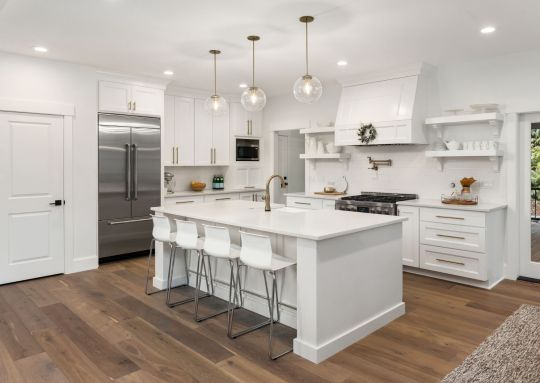
The Role of Kitchen Island Sizes in Daily Function
Kitchen islands have quickly evolved from optional additions to must-have centerpieces in modern kitchens. They offer counter space for food prep, additional storage, a gathering spot for family, and even a makeshift desk for working from home. There are various types of kitchen islands, such as stationary islands, rolling islands, and custom islands. But the key to getting the most out of your island is choosing the right size and type for your kitchen layout.
Kitchen island sizes vary widely depending on the space available. For compact kitchens, a smaller island—around 3 to 4 feet long—can provide prep space without overwhelming the room. For larger, open-plan kitchens, islands can stretch to 7 feet or more, comfortably incorporating sinks, dishwashers, or seating areas.
However, the size of the island and the spacing around it matter just as much. You want to ensure at least 36 inches of clearance for smooth movement. This allows multiple people to navigate the kitchen at once without crowding.
Enter the Pull Out Kitchen Faucet
Now that you've established the island size that fits your kitchen, it's time to add function to your form. That's where a pull-out kitchen faucet comes in. While they might not be the flashiest feature at first glance, these faucets have become a staple in modern kitchens—and for good reason.
Unlike fixed faucets, pull-out models feature a hose that extends from the faucet body, allowing for more flexible use. For instance, rinsing vegetables, filling pots, or cleaning the sink becomes a breeze. This flexibility can save time and reduce kitchen mess for busy households or those who cook often.
When installed on a kitchen island, a pull out faucet transforms a standard prep sink into a multi-functional workstation. It allows you to switch from meal prep to clean-up without walking across the kitchen. Plus, many modern designs come in sleek finishes and minimalist forms that complement any island style—from rustic farmhouse to contemporary chic, giving you the power to customize your kitchen.
A Balanced Design for Better Living
Pairing an appropriately sized island with a pull out faucet isn't just about aesthetics—it's about daily usability. The right island gives you room to cook, gather, and entertain. The right faucet helps you move seamlessly through tasks. Together, they create a central hub that feels less like a chore zone and more like a natural extension of how you live.
As you plan or remodel your kitchen, consider how things look and how they work together. A thoughtfully selected island size can define the room's flow, which refers to the ease of movement and the logical arrangement of elements in the kitchen, while a versatile faucet brings that flow to life.
Designing a kitchen that suits your lifestyle means making choices that balance form and function. Whether you're renovating an existing space or building from scratch, choosing the right kitchen island size and a reliable pull out kitchen faucet is an investment in everyday comfort and efficiency. It's about creating a space that looks good and works well, inspiring you to enjoy your time in the kitchen.
With the proper layout and fixtures, your kitchen becomes more than just a cooking space, it becomes the true heart of your home.
0 notes
Text









A Home That Truly Works For You
— 20 Barley Road Flat Bush
This 7-bedroom, 5.5-bathroom home is the perfect blend of space, comfort, and practicality. Thoughtfully designed for modern living, it offers flexibility for large families, multi-generational households, or those who love to entertain.
What makes this home stand out?
• Self-contained 2-bedroom granny flat – Complete with its own living area, bathroom, separate entrance, and sub-power meter, making it ideal for extended family or rental income.
• Five Bedrooms Upstairs including Four spacious master suites – Everyone gets their own private space with an ensuite and generous wardrobe.
• Multiple living areas – A separate formal lounge for quiet moments and open-plan spaces for everyday living and entertaining.
• Well-equipped kitchen + butler’s kitchen – High-end appliances, plenty of storage, and a functional island bench make cooking easy and enjoyable.
• Seamless indoor-outdoor flow – The sun-filled dining and living areas open to a large deck and low-maintenance garden, perfect for relaxing or hosting guests.
• High-spec features throughout – Central air conditioning, built-in sound system, double-glazed windows, and more for year-round comfort.
• Great school zones – Zoned for Te Uho O Te Nikau Primary, Ormiston Junior College & Ormiston Senior College.
Prime location – Close to Ormiston Town Centre, Botany Junction, shopping, cafes, restaurants, and easy motorway access.
A home that truly works for you—whether you need space, privacy, or convenience, this one ticks all the boxes. Get in touch today to arrange a viewing! Call us now
Ajay Gulati - Barfoot & Thompson- 021 236 2008
#ExtendedLiving #GrannyFlat #Freehold #SellitNow #Versatile #ClearInstructions #MultiGenetation #7Bedrooms #BarfootandThompson Barfoot & Thompson Manukau #RealEstate #GULATI #BarleyRoad #FlatBush Ajay Gulati Highlight @followers
https://www.barfoot.co.nz/910400
0 notes
Text






I.Inverter selection basis
1.1. "Shell Protection Level (IP code)" GB 4208
1.2. "Photovoltaic power generation grid-connected inverter technical requirements" GB/T 37408
1.3. "Photovoltaic power station access to power system technical regulations" GB/T 19964
1.4. "Electrical and electronic products basic environmental test procedures" GB/T2423
1.5. "Grid-connected photovoltaic Inverter Technical conditions" CNCA/CTS 0004
1.6. "Photovoltaic grid-connected system inverter anti-island test method" IEC 62116
1.7. Safety of Inverter for Photovoltaic power generation IEC 62109-1/2
1.8. "Photovoltaic grid-connected inverter Technical specification" NB/T32004
2. Design parameters
2.1The inverter is the core equipment and technical key of the photovoltaic system, converting the direct current emitted by the battery array into AC power that is easy to be transmitted over a long distance after voltage boost. The grid-connected inverter can adjust the frequency, voltage, current, phase, active power and reactive power of the AC output side of the inverter according to the power characteristics of the connecting point.
Classification of inverters is shown in Table 1:
2.2 Centralized inverter
The centralized inverter summarizes the DC generated by the photovoltaic module into a larger DC power and then inverts it. The power of this type of inverter is relatively large, and the single capacity is generally above 500KW. It has the advantages of large output power, mature technology, high power quality and low cost, but at the same time it has the disadvantage of insufficient MPPT tracking accuracy. It will affect the efficiency and electrical capacity of the entire photovoltaic power station when it encounters cloudy, shaded or a single series failure, and requires a dedicated room for ventilation and heat dissipation, so the variety is usually used in centralized large-scale photovoltaic power stations with uniform light
2.3 String inverter
Several groups of photovoltaic series for a separate maximum power peak tracking, and then after the inverter into the AC power grid, this type of inverter power is relatively small, single power is generally below 100KW, with the technical progress and cost reduction and efficiency demand is becoming increasingly prominent, the power gradually increased to 136KW, 175KW and other high-power products. It has the advantages of large number of MPPT, flexible component configuration, easy installation, high tracking accuracy, high power generation, fast operation and maintenance, but also has the disadvantages of slightly poor power generation quality and high cost, mainly used in small-scale household distributed power generation, small and medium-sized industrial and commercial rooftop power stations.
2.4 Distributed inverter
Distributed inverter realizes multi-channel MPPT optimization function by pre-controlling multiple MPPT optimizers, and adopts centralized inverter inverter after convergence. This type of inverter combines the advantages of "centralized inverter" and "decentralized MPPT tracking" of large-scale centralized photovoltaic inverters to achieve low cost and high reliability of centralized inverters and high power generation of serial inverters. According to the Sobi photovoltaic network, the distributed type is 2%-5% higher than the centralized power generation, and has better power quality, grid adaptability and lower system investment costs than the string inverters
2.5 Micro inverter
Micro inverter for each photovoltaic module for a separate maximum power peak tracking, and then through the new energy power generation after the inverter into the AC grid, this type of inverter single capacity is generally less than KW, with each component independent maximum power tracking control, in the case of shading or component performance differences to improve the overall efficiency, to minimize safety risks and other advantages. Its disadvantage is high price, more difficult to maintain after failure, more suitable for smaller projects.
3. Inverter selection requirements
3.1 The requirements of the State Grid for distributed photovoltaic power stations are as follows: 220V can be accessed below 8kW; 8kW~ 400kW can be connected to 380V; 400kW~6MW can be connected to 10kV. According to the characteristics of the inverter, the selection of photovoltaic power plant inverter is shown in the figure:
3.2 The roof of 10kV project is generally a large roof, a single roof arrangement of the roof capacity of up to MW, a single inverter under the same MPPT circuit of the photovoltaic module inclination, orientation and shadow occlusion is consistent, it is recommended to choose a centralized inverter.
3.3 The design of the roof photovoltaic power station is relatively complex, affected by the roof structure, size, layout, materials, bearing and shadow occlusion and other factors, need to maximize the benefits through the photovoltaic module laying and inverter selection planning. The layout of photovoltaic modules on the roof is mostly blocked or the orientation is inconsistent, in order to simplify the design, it is recommended to choose a series inverter.
3.4 The roof of the plant is mostly color steel roof, bearing limited, can not install a series of inverters, and need to meet the daily maintenance, does not affect the normal production and operation requirements, can choose a centralized inverter.
4.Inverter installation requirements
4.1. Environmental requirements
4.1.1 There should be no flammable and explosive materials in the installation environment; 1.2 Should not be installed in places accessible to children:
4.1.3 Temperature and humidity should meet the following requirements:
Maximum ambient temperature :+60℃; Minimum ambient temperature :-30℃; Maximum relative humidity :100%(non-condensing)
4.1.4 To avoid direct sunlight, direct rain and snow, extend the service life of the inverter, outdoor installation of the inverter should be set in a position that can shade the sun and rain:
4.1.5 To ensure smooth ventilation and heat dissipation of the inverter, it is appropriate to install the inverter in a ventilated environment :1.6 for 10kV series inverters or centralized inverters, the inverter should be installed in a position greater than 30m away from third-party wireless communication facilities or residential.
4.2 Installation carrier requirements
4.2.1 The installation carrier should not be flammable material:
4.2.2 The maximum bearing capacity of the carrier is >4 times the weight of the inverter.
3.Angle
4.3.1 Vertical installation or backward tilt installation of inverters (the required Angle to the ground >10°), should not be installed forward or upside down:
4.3.2 The installation height of the inverter meets the requirements of the turning radius of the cable and is convenient for personnel to operate.
4.Protectionfunctionrequirements
(1) DC input side overvoltage protection
(2) AC output side overvoltage/undervoltage protection
(3) AC overpass/underfrequency protection:
(4) DC input or AC output polarity misconnection protection
(5) AC output side phase protection
(6) DC input overload protection
(7) Output short-circuit protection:
(8) DC side back discharge protection
(9) Anti-island effect protection:
(10) The function of restoring the grid connection when the frequency voltage on the AC side returns to normal:
(11) High temperature cooling protection function:
(12) Lightning protection.
5, inverter DC input voltage requirements
(1) Under the extreme low temperature operating conditions of the photovoltaic module, the open circuit voltage of the photovoltaic series DC side is < the maximum DC input voltage of the inverter:
(2) Under extreme low temperature working conditions, the working voltage of the DC side of the PV module is < the maximum voltage of the inverter Mppt;
(3) Under the extreme high temperature operating conditions, the working voltage of the PV series DC side is > the minimum voltage of the inverter Mppt.
1.5 To ensure smooth ventilation and heat dissipation of the inverter, it is appropriate to install the inverter in a ventilated environment :1.6 for 10kV series inverters or centralized inverters, the inverter should be installed in a position greater than 30m away from third-party wireless communication facilities or residential.
2 Installation carrier requirements
2.1 The installation carrier should not be flammable material:
2.2 The maximum bearing capacity of the carrier is >4 times the weight of the inverter. The Angle is required
3.1 Vertical installation or backward tilt installation of inverters (the required Angle to the ground >10°), should not be installed forward or upside down:
3.2 The installation height of the inverter meets the requirements of the turning radius of the cable and is convenient for personnel to operate. 4
(1) DC input side overvoltage protection (2) AC output side overvoltage/undervoltage protection
(3) AC overpass/underfrequency protection:
(4) DC input or AC output polarity misconnection protection
(5) AC output side phase protection
(6) DC input overload protection
(7) Output short-circuit protection:
(8) DC side back discharge protection
(9) Anti-island effect protection:
(10) The function of restoring the grid connection when the frequency voltage on the AC side returns to normal:
(11) High temperature cooling protection function:
(12) Lightning protection.
4.Inverter DC input voltage requirements
(1) Under the extreme low temperature operating conditions of the photovoltaic module, the open circuit voltage of the photovoltaic series DC side is < the maximum DC input voltage of the inverter:
(2) Under extreme low temperature working conditions, the working voltage of the DC side of the PV module is < the maximum voltage of the inverter Mppt;
(3) Under the extreme high temperature operating conditions, the working voltage of the PV series DC side is > the minimum voltage of the inverter Mppt.
5..lnverter vertical installation diagram
5.1. This figure is suitable for vertical installation of inverters and installation of color steel tile roof brackets.
5.2. Sun shield/brace/beam/column/stainless steel shield/bottom beam/guide rail/color steel tile fixture
5.2.1 Inverter mounting holes and bolt specifications
Inverter weight <100kg Bolt M8~M10
100kg ≤ Inverter weight ≤ 200kg Bolt M12 to M16
Inverter weight >200kg M20 and above
5.3. Design reference parameters
5.3.1 Maximum wind pressure: 0.38kN/m²; Maximum snow pressure: 0.40kN/m²;
Ground roughness: Class B
5.3.2 The inverter power example is 100kW, the specific project can be further designed according to the actual situation.
Grounding measures should be taken according to the requirements of the design document, and the grounding flat steel should be connected with the photovoltaic bracket, inverter and photovoltaic array.
5.4. Other installation requirements
5.4.1 The inverter back plate must be perforated according to the installation hole positions, and secured by bolts of the corresponding specifications.
5.4.2 After the column and bottom beam are installed, waterproof and glue should be applied to ensure long-term safety.
2. .Concreteroofsupportverticalinstallationdiagram
2.1. This drawing is suitable for vertical installation of inverters and vertical installation of concrete roof supports.
2.2. Mounting accessories are bolts/expansion bolts/purlins/ground copper wire/ground flat steel/post/anchor bolt
2.3.1 Design reference natural conditions: maximum wind pressure: 0.38kN/㎡; Snow pressure: 0.40kN/㎡; The ground roughness is class B.
2.3.2. This drawing uses the inverter power of 100kW as an example, and designers can deepen the design according to specific projects;
2.3.3. Design the grounding measures according to the requirements of the inverter and the design document, and the grounding flat steel is connected with the photovoltaic bracket and photovoltaic array

6. Wall installation diagram of wall-mounted inverter
6.1. This drawing is suitable for wall installation of inverters
6.2. Installation accessories include bolts, expansion bolts, beams, ground copper wires, and ground flat steel
6.3.1 Design reference natural conditions: maximum wind pressure: 0.38kN/㎡; Snow pressure: 0.40kN/㎡; The ground roughness is class B.
6.3.2. This drawing uses the inverter power of 100kW as an example, and designers can deepen the design according to specific projects;
6.3.3. Design the grounding measures according to the requirements of the inverter and the design document, and the grounding flat steel is connected with the photovoltaic bracket and photovoltaic array
0 notes
Text
Modern Luxury Kitchens: The European Influence You Didn’t Know You Needed
Kitchen spaces have undergone a functional re-evaluation. What was once a closed-off utility zone has become a central design element, equal parts domestic infrastructure and aesthetic showcase. While open layouts and integrated appliances are now common, their origins are more specific than many realize. The quiet influence of European kitchen philosophy—particularly from Germany and Scandinavia—has been instrumental in normalizing a vision of the kitchen that prioritizes efficiency, visual unity, and sustainability.
Today’s iteration of the luxury kitchen leans heavily on ergonomics and materials science. Unlike earlier conceptions based on maximalism, modern interpretations are rooted in functional clarity. Precision, balance, and durable design replace ornamentation as markers of refinement. This article will examine how this shift took place, and why the European model is now a cornerstone in contemporary kitchen planning.
Philosophical Underpinnings of European Kitchen Design
The influence of Bauhaus design on the contemporary European kitchen cannot be overstated. Form following function is not simply a design maxim; it’s the foundational logic. Kitchens shaped by this view minimize the unnecessary, foregrounding use-value while maintaining formal coherence. A sense of seamless integration is not aesthetic alone—it derives from the belief that well-designed tools enhance life quality.
Integral to this is the notion of "Gesamtkunstwerk"—a total work. European kitchens strive for unbroken visual continuity and cohesion. Built-in appliances are not indulgences; they’re logistical necessities in realizing spatial equilibrium. Storage is not a secondary concern but a primary structural element. Visual clarity becomes a practical affordance, simplifying navigation and maintenance while fostering a calming domestic atmosphere.
These design values are implicitly ideological. They resist excess and promote mindfulness in both consumption and habitation. In an era of environmental concern and spatial scarcity, this philosophy is more timely than ever.
Materials and Textures: The European Palette
Material selection in modern European kitchens prioritizes endurance, tactility, and neutrality. Oak, walnut, engineered stone, and ceramic composites appear often—not as status symbols but for their resilience and visual restraint. Matte finishes dominate. Gloss is minimal. Metallic accents are used sparingly and deliberately, often in muted tones such as blackened brass or brushed steel.
Glass is employed as a mechanism for light diffusion, not display. The overall visual field of the kitchen is intended to be subdued, supportive, and contextually adaptive. Monochromatic palettes aren’t minimal for trendiness but because they offer less friction in multi-use spaces.
These material decisions coincide with manufacturing shifts. Recyclability, ethical sourcing, and low-emission production are no longer fringe concerns. As European kitchen brands standardize sustainability, materials become nodes in an environmental supply chain, not just design variables. The resulting aesthetic is an echo of ethical priority.
Spatial Dynamics and the Open Kitchen Concept
European kitchen planning emphasizes contiguous spatial logic. Kitchens no longer terminate at thresholds—they flow. The removal of visual and architectural partitions between cooking and social spaces is not incidental. It is a consequence of the redefinition of cooking as communal.
Rather than simply enlarging the kitchen, European designers structure space through unobtrusive zoning. Islands serve as informal borders. Seating areas blend into preparation zones. The spatial narrative shifts from containment to coherence. Layouts are guided by activity patterns, not decorative intent.
Work surfaces follow ergonomic logic. Cabinets open in multiple axes. Lighting is subdivided into categories of purpose: task, ambient, accent. Rather than spotlighting individual features, lighting in these spaces clarifies orientation. European kitchens are neither over-lit nor dimly stylized—they are calculated environments of use.
Technological Integration and Smart Functionality
Contemporary kitchens include technology as a layer, not a feature. In European models, technological visibility is downplayed. The aim is functional invisibility. Ovens disappear into cabinetry. Refrigerators resemble walls. Devices are controlled by touch or voice, but their physical presence remains minimal.
Induction cooktops, automated extractors, and temperature-regulated drawers are standard. However, these integrations are not presentational. They serve task-flow efficiency and sensory balance. No feature exists to impress; every feature exists to improve task execution.
This approach also affects ventilation, acoustics, and environmental consistency. Flush-mounted extractor systems and cabinet-integrated air controls mitigate disruption. European kitchens do not entertain technological excess. They invite focused technological application.
Customization and Personalization in Layout and Use
European kitchen systems are fundamentally modular. This allows for configurational flexibility without deviation from structural coherence. Customization is encouraged, but within pre-set constraints of the design vocabulary.
Clients can select cabinetry depths, counter heights, and internal configurations. However, the systems discourage over-customization. The goal is to balance individuality with spatial rationality. A coffee niche or a baking station is not treated as a theme—it's a utilitarian allocation of sub-space.
Material palettes can be specified from curated swatches. Lighting color temperatures can be tuned. But in all cases, customization is oriented toward spatial use, not aesthetic spectacle. European kitchens are less about personalization as identity and more about optimization as practice.
How German Kitchens Exemplify European Design Excellence
Precision engineering is perhaps most visible in German kitchens. These systems exemplify modular integrity, hardware durability, and spatial logic. The visual character is uniformly quiet: handleless cabinetry, matte finishes, and intersecting planes devoid of excess linework.
Hardware is engineered for repetition and longevity—soft-close drawers, anti-slam doors, hidden tracks. Storage is concealed, modular, and adaptive. It supports the entire premise of visual reduction.
Materials are chosen for predictability in aging. Finishes are tested for abrasion and humidity. Cabinet systems are built not to adjust trends but to survive decades of heavy use. German kitchen design is less style and more infrastructure. That’s why it endures.
The Contemporary Definition of a Modern Luxury Kitchen
The contemporary modern luxury kitchen is not defined by visual opulence but by the synthesis of use and restraint. In the European context, luxury is about invisibility—seamless materials, intuitive access, silent hardware. It’s a design that disappears into the background of living.
Luxury, here, is time: less time spent maintaining, navigating, or troubleshooting. It is also space—useful space, ambient space, space freed by function. And it is sensory clarity: neutral materials, soft acoustics, consistent lighting.
This marks a shift from status to utility, from branding to longevity. The European kitchen is a laboratory of durable decisions. As a result, it’s increasingly the global template for what a luxury kitchen should mean in the 21st century.
Conclusion: Embracing the Essential Elegance of European Kitchens
European kitchen design offers a framework that combines practicality with philosophical clarity. It’s not a decorative scheme—it’s a spatial ethic. It privileges coherence, longevity, and restraint. And in doing so, it defines a new kind of luxury.
To adopt this model is to participate in a broader design evolution—one in which the kitchen is not a showcase but a support system. The metrics change: from visual wow to operational ease, from trend adoption to systemic thinking. European kitchens are less a style and more a standard. And that is exactly what makes them compelling.
0 notes
Text
The Trends Locals Can’t Stop Talking About: kitchen renovations in inner west sydney!

Sydney's Inner West is currently undergoing a reno boom, especially in the kitchen. Sydney residents are refurbishing their kitchens with a chic makeover that combines modern living with Inner West's individual heritage. Here are the top trends for kitchen renovation in inner west sydney that are impressing Inner West residents.
Kitchen Renovation Trends in Sydney Inner West!
Moving Towards Open-Plan Layouts
One of the inner west's biggest trends is building open-plan living areas.
Homeowners are knocking down walls to blur the line between kitchens, living and dining rooms.
The style maximises the feeling of space and light and is perfect for entertaining and family living.
Multi-functional islands are a hub feature, which is used as prep stations, dining areas, and work areas, with integrated hidden storage systems to maintain a tidy kitchen.
Prioritising Heritage and Character
The Inner West is famous for its quaint Victorian terraces, Federation houses, and Art Deco apartments.
Restorations in the area tend to balance retaining historical elements with the addition of modern design.
Retaining period details like cornices, fireplaces, and stained-glass windows give a special character that buyers adore.
This preserves the history of the area while updating homes for modern lifestyles.
Upgrading with High-End Finishes and Appliances
Kitchens are usually the central attraction for Inner West renovations.
Homeowners are choosing modern, sophisticated designs, top-of-the-line appliances, and intelligent storage systems that are maximally functional.
Such renovations can also bring spectacular returns on investment, as even basic kitchen renovations can greatly boost property value.
Sustainable and Eco-Friendly Choices
Sustainability is increasingly a point of focus during kitchen remodelling.
Most homeowners are including green materials and energy-saving appliances in their layouts.
Recycled glass countertops, bamboo cabinetry, and reclaimed wood floors are becoming increasingly popular, enabling occupants to merge aesthetics with ecological sensitivity.
Optimising Space through Innovative Designs
Space maximisation is key in most Inner West houses.
Popular renovation trends involve floor-to-ceiling shelving, strategically placed hooks, and creative under-stair storage.
Skylights are also utilised to provide additional natural light to kitchens, which improves the ambience without consuming a lot of energy.
Combining Bold Colors and Statement Pieces
Today's kitchen trends include statement pieces and bold colours that express individual styles.
From traditional to modern designs, Inner West renovations are tailored to individual tastes.
Homeowners collaborate with designers to decide what will work best for them and how to make it happen.
Prioritising Functional and Fashionable Solutions
Inner West renovations focus on functional yet fashionable solutions.
Benchtop resurfacing with marble or stone overlays is an affordable method of bringing kitchens up to date without massive renovations.
Such designs take their cues from the rich heritage and multicultural influences that characterise the Inner West community, with the intention of creating houses that speak to local character.
In light of Suburb-Specific Styles
Various suburbs in the Inner West have distinct styles of renovation that suit their nature. Balmain is famous for high-end renovations of old terraces, while Newtown specialises in space maximisation in smaller houses with innovative designs. Marrickville has the potential for warehouse conversions and contemporary looks, while Leichhardt's heritage houses are being renovated and modernised.
Kitchen makeovers in Inner West Sydney are about combining contemporary style with the local area's character. From open-plan living and high-end finishes to eco-friendly options and space-saving solutions, locals are designing kitchens that are both functional and fashionable. These makeovers not only improve the quality of everyday living but also add to the Inner West's sense of community spirit.
0 notes
Text
Top Kitchen Renovation Trends for Narooma Homes
Renovating your kitchen is one of the most exciting ways to breathe new life into your home. In Narooma, where coastal beauty meets a relaxed lifestyle, homeowners are embracing kitchen designs that reflect both functionality and style. Whether you're planning a full renovation or just a few updates, keeping up with the latest trends can help you create a space that’s both modern and timeless. Here are the top kitchen renovation trends that are making waves in Narooma homes.
6 Top Kitchen Renovation Trends
Coastal-Inspired Designs
Given Narooma’s stunning seaside location, it is no surprise that coastal-inspired kitchens are a top trend. Homeowners are opting for light and airy designs that bring the beauty of the outdoors inside. Imagine white or soft blue cabinetry, natural wood elements, and large windows that allow for plenty of sunlight. These kitchens often feature open shelving to showcase dishes and décor, creating a space that feels both welcoming and relaxed.
Sustainable Materials
Sustainability is becoming a significant focus in kitchen renovations in Narooma. More homeowners are choosing eco-friendly materials like recycled timber, bamboo, and reclaimed stone for their kitchen spaces. Not only do these materials add a unique, natural touch to the design, but they also align with the growing emphasis on environmental responsibility. Incorporating energy-efficient appliances and water-saving fixtures further enhances the eco-friendly appeal of your kitchen.

Bold Colour Schemes
While white kitchens remain popular, many Narooma homeowners are now gravitating towards bolder colour choices. Deep blues, forest greens, and rich charcoal tones are being used to create a striking contrast with lighter countertops and backsplashes. These darker hues add depth and sophistication to the kitchen, making it a standout feature of the home. Pairing these colours with gold or brass hardware can add a touch of luxury and warmth to your kitchen.
Multi-Functional Islands
The kitchen island has evolved from a simple prep area to the central hub of the kitchen. In Narooma, multifunctional islands are trending, offering additional storage, seating, and even built-in appliances. These islands serve as a place to cook, eat, and socialise, making them an essential element in modern kitchens. Some designs also include features like wine coolers, sinks, or pullout chopping boards to maximise functionality.
Smart Kitchens
Technology is playing a more significant role in kitchen renovations than ever before. Smart kitchens, equipped with the latest gadgets and appliances, are becoming increasingly popular in Narooma homes. From touchless faucets and smart ovens to voice-controlled lighting and integrated coffee machines, these innovations make cooking more efficient and enjoyable. Smart kitchens also enhance safety, with features like sensors that alert you if the oven is left on or the fridge door is open.
Natural Stone Countertops
Natural stone countertops, such as granite, marble, and quartz, continue to be a favourite among Narooma homeowners. These materials not only provide durability but also add a sense of elegance to the kitchen. Each slab of natural stone is unique, offering a one-of-a-kind pattern that can serve as the focal point of your kitchen design. Whether you prefer the classic look of marble or the rugged beauty of granite, natural stone is a timeless choice.
Conclusion
Kitchen renovations in Narooma are all about blending style with functionality, making sure your space is not only beautiful but also practical for everyday use. Whether you are drawn to the coastal vibes, bold colours, or the latest technology, these trends can help you create a kitchen that truly feels like the heart of your home. Explore these trends and bring your vision to life with the help of experts in kitchen renovations in Narooma.
Renovating your kitchen is one of the most exciting ways to breathe new life into your home. In Narooma, where coastal beauty meets a relaxed lifestyle, homeowners are embracing kitchen designs that reflect both functionality and style. Whether you're planning a full renovation or just a few updates, keeping up with the latest trends can help you create a space that’s both modern and timeless. Here are the top kitchen renovation trends that are making waves in Narooma homes.
Disclaimer: This is generic Information & post; content about the services can be changed from time to time as per your requirements and contract. This is written for only SEO purposes; we are not claiming it is 100% accurate as it's general content. The images we use in this context have been taken from the official website of Coast to Country Kitchens. To get the latest and updated information, contact us today or visit our website.
#kitchens renovations#kitchen renovations#bathroom renovation#renovations batemans bay#kitchen renovation#kitchen services#custom joinery batemans bay
0 notes
Text
The Best Room Layouts for Entertaining Guests: Interior Design Edition
Hosting guests is an art, and the right interior design can make all the difference in creating a comfortable, engaging space. Whether you’re planning a lively party or an intimate gathering, your home’s layout should enhance conversation, comfort, and flow. Here are the best interior design strategies for entertaining guests.
1. The Open-Concept Layout
An open-concept space remains one of the most effective layouts for entertaining. By eliminating unnecessary walls, you create a seamless flow between the kitchen, dining, and living areas. This design fosters interaction, allowing guests to move freely and engage in conversations without barriers. Incorporate a well-placed kitchen island or breakfast bar to encourage socializing while preparing food and drinks. Use area rugs and statement lighting to subtly define each zone without breaking the openness.
2. The Circular Seating Arrangement
For intimate gatherings, a circular or semi-circular seating arrangement fosters an inviting and inclusive atmosphere. Position sofas and chairs around a central focal point such as a coffee table, fireplace, or statement rug. This layout ensures face-to-face conversations, making every guest feel included. Opt for plush seating and accent pillows to enhance comfort, and use layered lighting with floor lamps and sconces to add warmth.
3. The Multi-Zone Layout
A spacious living area can be transformed into a dynamic entertainment space by creating multiple functional zones. Define areas for lounging, dining, and interactive activities like board games or music. Utilize furniture placement, area rugs, and strategic lighting to establish distinct yet cohesive sections. Consider incorporating a mix of seating options, such as sofas, armchairs, and ottomans, to encourage flexibility and movement.
4. The U-Shaped or L-Shaped Layout
A U-shaped or L-shaped furniture arrangement maximizes seating while maintaining an inviting and conversational atmosphere. These layouts naturally direct attention toward a focal point, such as a fireplace, media console, or statement artwork. Enhance the arrangement with accent tables, decorative trays, and cozy throws for a polished yet relaxed aesthetic. Add ottomans or stools for additional seating without compromising style.
5. The Bar and Lounge Setup
For a sophisticated and relaxed ambiance, a bar and lounge-style layout is an excellent choice. Designate a chic corner with a stylish bar cart or built-in bar area accompanied by high stools. Complement this with plush lounge seating, such as velvet chairs or modular sofas, to create an inviting environment for cocktail parties and casual gatherings. Use dimmable lighting and metallic accents to enhance the upscale feel.
6. The Indoor-Outdoor Layout
Maximize your entertaining potential by seamlessly integrating indoor and outdoor spaces. If you have access to a patio, balcony, or garden, use sliding or French doors to create a fluid transition. Outdoor furniture, ambient string lights, and a fire pit can extend the entertaining area while adding warmth and charm. Choose weather-resistant materials that complement your indoor design for a cohesive look.
7. The Theater-Style Arrangement
For movie nights or special screenings, a theater-style layout creates an immersive experience. Arrange deep, comfortable sofas or recliners in rows facing a large screen. Incorporate soft lighting, side tables for snacks and drinks, and cozy blankets to enhance the cinematic feel. Soundproofing elements like thick curtains and plush rugs can also improve acoustics and ambiance.
Final Tips for the Perfect Entertainment Space
Ensure smooth traffic flow: Arrange furniture to allow guests to move effortlessly throughout the space.
Incorporate flexible seating: Use poufs, benches, or nesting tables that can be easily repositioned for different group sizes.
Layer lighting: Mix ambient, task, and accent lighting to create a dynamic and adaptable atmosphere.
Personalize the space: Art, books, and curated decor add character and make guests feel at home.
A well-designed room layout enhances your hosting experience and ensures that your guests feel welcomed and comfortable. Whether you prefer cozy conversations, vibrant parties, or elegant dinners, these interior design strategies can transform your space into the ultimate entertaining hub.
0 notes
Text
5 Innovative Kitchen Layouts for Modern Living
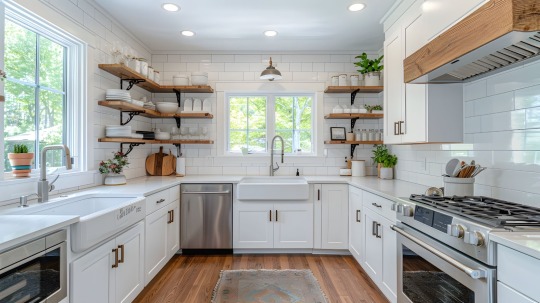
As we explore the realm of modern kitchens, we can’t help but notice how innovative layouts can transform our cooking spaces into hubs of activity and style. Open concept designs invite interaction, while central islands offer both efficiency and social engagement. With the right materials and finishes, these kitchens not only serve practical purposes but also elevate our home aesthetics. So, what are the specific layouts that can redefine our culinary experiences and align with our contemporary lifestyles? Let’s uncover three standout options that promise to enhance both function and flair.
Open Concept Layout
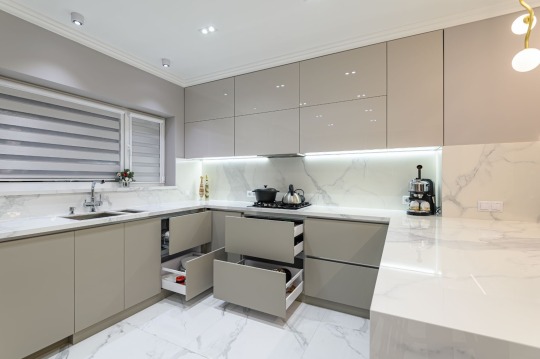
While many of us cherish the idea of a spacious, inviting kitchen, the open concept layout truly transforms the way we interact with our homes. It creates a seamless flow between the kitchen and adjacent living spaces, making gatherings more enjoyable and intimate.
We love how this design fosters social interactions, allowing us to cook, dine, and entertain in a multifunctional area.
One of the standout features of an open concept layout is the incorporation of kitchen islands. These islands not only provide additional counter space but also serve as a hub for family and friends.
We can easily pull up chairs or bar stools, turning the kitchen into a lively gathering spot. Plus, with the right design, even small islands can maximize utility in compact spaces.
Abundant natural light is another key aspect of creative open kitchen layouts. Large windows brighten up the space, making it feel airy and inviting.
Combining these elements results in a kitchen that balances functionality and aesthetics, reflecting our modern lifestyles while enhancing our daily experiences at home.
Central Island Innovations

Open concept layouts naturally lead us to explore the innovations surrounding central islands, which have become pivotal in modern kitchen design.
These kitchen islands not only enhance functionality but also serve as the heart of our culinary spaces. By incorporating custom islands, we can maximize efficiency and create inviting environments for family and friends.
Here are some exciting innovations we can consider:
Integrated appliances: Streamline our kitchen with built-in ovens or dishwashers.
Space-saving solutions: Utilize peninsulas or drawers for optimal storage.
Breakfast bar: Add a casual dining space perfect for quick meals or morning coffee.
Dual finishes: Choose contrasting materials for a stylish, cohesive look.
Durable materials: Incorporate porcelain stoneware for longevity and ease of maintenance.
The practical benefits of central islands are numerous. They provide extra work surfaces, keep our counters organized, and create inviting areas for socializing.
With the right design, a kitchen island becomes more than just a functional element; it transforms our kitchens into dynamic spaces where we can gather, cook, and connect with loved ones.
Multi-Functional Spaces

As we delve into the concept of multi-functional spaces, we realize how essential they’re in modern kitchen design. These areas are more than just cooking zones; they serve as gathering places where family and friends can connect.
In our kitchen remodeling projects, we often prioritize open layouts that encourage interaction, allowing hosts to engage with their guests while preparing meals.
Incorporating adaptable kitchen features, like a prep sink on the central island, enhances this experience, as it keeps everything within reach. If space is limited, alternative seating options like breakfast nooks provide casual dining areas, promoting a relaxed atmosphere.
To streamline our kitchen workflow, we strategically arrange tools and appliances, minimizing unnecessary movement between workstations. This efficiency transforms our cooking and entertaining processes.
Additionally, universal design principles ensure that these multi-functional spaces are accessible for all ages and abilities, with features like single-handle faucets for easy use.
Ultimately, creating multi-functional spaces in our kitchens reflects our diverse family needs, enhancing both functionality and enjoyment in our daily lives.
Natural Light Integration

Bringing natural light into our kitchens isn’t just about aesthetics; it transforms the entire space, making it feel more inviting and spacious.
By thoughtfully integrating natural light, we can create a warm atmosphere that enhances our cooking and dining experiences.
To achieve this, we can explore innovative strategies, such as:
Optimizing window placement to maximize sunlight exposure.
Incorporating glass walls that maintain separation while allowing light to flow freely.
Implementing reflective surfaces like gloss finishes and light-colored materials that bounce light around the room.
Utilizing skylights or sun tunnels to bring in overhead light without compromising wall space.
Adopting an open layout, removing barriers between the kitchen and adjacent rooms to increase natural light intake.
These approaches not only brighten our kitchens but also connect us to the outdoors, making our spaces feel larger and more connected.
Embracing these ideas, we can enjoy the benefits of natural light while crafting a kitchen that’s both functional and beautiful.
Textured Materials and Colors

Natural light enhances our kitchens, but to truly elevate the space, we need to consider the role of textured materials and colors. By integrating various textures, we can create a warm and inviting atmosphere that engages all our senses.
For instance, choosing wood cabinets adds a natural warmth, while a striking backsplash tile introduces visual interest. The combination of these elements not only enhances the design but also contributes to a cohesive look throughout the kitchen.
When selecting a color palette, we should aim for harmony. Layering different textures—like smooth countertops with rough stone or glossy cabinet finishes—creates depth and dimension.
We can also play with contrasts; a matte wood cabinet paired with a shiny metallic faucet draws attention and adds sophistication.
Additionally, accessories like woven baskets or vibrant plants can introduce organic textures that soften the overall aesthetic.
By thoughtfully mixing textured materials and colors, we transform our kitchens into dynamic spaces that reflect our personal style and enhance functionality.
Let’s embrace these design principles to create a kitchen that’s not just beautiful, but also a true reflection of modern living.
Frequently Asked Questions
What Is the New Look for Kitchens in 2025?
We’re excited about the new kitchen look for 2025! Expect multifunctional islands, warm color palettes, eco-friendly materials, and smart technology integration, all creating inviting spaces that blend functionality with a contemporary aesthetic for modern living.
What Is the 3x4 Kitchen Rule?
The 3x4 kitchen rule helps us create an efficient workspace by keeping our sink, stove, and refrigerator within 4 to 9 feet of each other. It makes cooking smoother and our kitchen more functional.
What Kitchen Design Never Goes Out of Style?
We believe timeless kitchen designs featuring warm neutrals, natural materials, and efficient layouts never go out of style. These elements create inviting spaces that blend functionality with aesthetics, ensuring they remain relevant for years to come.
What Kitchen Arrangement Is Most Popular in Modern Design?
When we consider popular kitchen arrangements in modern design, open floor plans stand out. They create seamless connections with living areas, encouraging social interactions and offering a spacious, inviting atmosphere that suits today’s lifestyles.
Conclusion
In exploring these innovative kitchen layouts, we’ve seen how they transform our cooking spaces into vibrant hubs of activity and connection. By embracing open concepts, central islands, and multi-functional areas, we create environments that support both functionality and style. Let’s not forget the importance of natural light and textured materials, which add warmth and character to our kitchens. As we design our homes, we can truly enhance our modern living experience by incorporating these thoughtful elements.
For quality cabinets that fit your needs, visit RTAHQ for a great selection of options.
#cabinet end shelf#complete kitchen cabinet set#rtahq#knock down cabinets#kitchen cabinets#laundry room#blue shaker kitchen#shaker maple cabinets kitchen#15 inch wide pantry cabinet#white shaker cabinets#quality cabinets#kitchen layouts#Popular in Modern Design#modern kitchens
0 notes